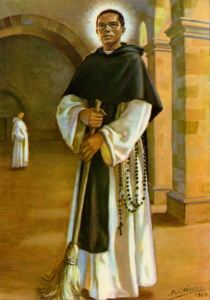“Ay, San Martin! San Martin en mi casa!” was the first thing my host abuela said to me as she held my face in her hands. My host aunt saw the look of confusion on my face and began explaining but all I could really understand was, “Ellla gusta tu color. Tu color es bonita.” If your Spanish is worse than mine that just means “She likes your color. Your color is pretty (#BlackGirlsRock).” I decided not to ask any questions because that was such a cute interaction and I wanted to ditch my heavy bags in my room as soon as possible. When I settled in, I started thinking its great that she thinks my melanin is on “fleek” but um… who in the world is Saint Martin?
When we were all watching TV later on in the evening I combined my limited investigation and language skills and asked “Quien es San Martin?” What followed was a long story in a slur of words I obviously could not understand. All I could get out of it was something about some rats & cheese & the fact that he was Moreno. And because my family only has a desktop computer and no wifi, I wasn’t able to fill in the huge gap left by my language shortcomings with a quick Wikipedia check.
When I finally did, I found out that Saint Martin was born Juan Martin de Porres Velazquez in Lima. He was the illegitimate son of a Spaniard and a freed slave from Panama. Although, never fully accepted by some of his Dominican Order brothers (who chose to label him as a “mulatto dog”), he remained extremely pious and maintained an austere lifestyle through fasting and not eating meat. It is even said that when his convent was in debt, he implored them, “I am only a poor mulatto. Sell me.” He is most known for miraculous knowledge, instantaneous cures, and the ability to communicate with animals – which probably explains whatever I heard about rats and cheese.
After his death, apparently the miracles invoked in his name increased so much that they exhumed my man’s body after 25 years. It was said to have been found completely intact and smelling quite lovely – like a fine French fragrance, if you will. He was beatified in 1837 and canonized in 1962. He is now the patron saint of mixed people (shout out to Samantha), innkeepers, barbers, and public health workers to name a few. And if you practice Santeria, you may also know him as Papa Candelo.
So I suppose all of this to say that when you’re Black in Peru, it is apparently common to hear “Ay, San Martin!” And you should consider yourself lucky, because the Peruvian who just called you Saint Martin thinks you’re a good luck charm of sorts.

One Comment Add yours